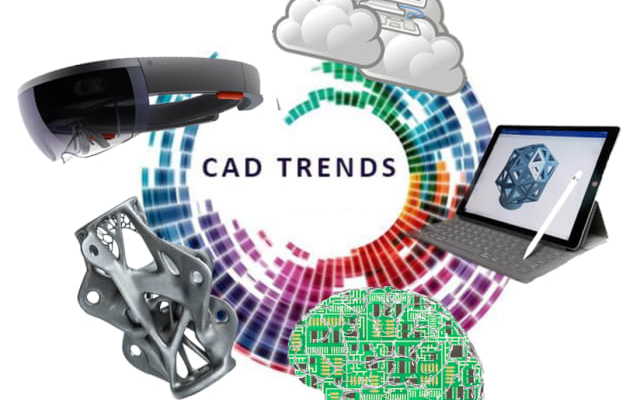
Trends in CAD Design Automation And How They Can Benefit You
July 28, 2021
Computer-aided design (CAD) software is used in many industries and in organizations of all sizes. As CAD is improving, it is increasing the efficiency of developing technologies. Four of the latest advancements involving CAD design automation that could benefit your company include:
- AI Integration and Improvement
- Cloud Deployment
- Model-Based Definition
- 3D Printing and VR Modeling
Let’s explore the details of each of these advancements, and how they can benefit you, in more detail.
AI Integration and Improvement
AI integration
Traditionally, engineering and manufacturing are handled separately. Engineers work in CAD application environments and have their own engineering bills of material (EBOM). They rarely use the company’s enterprise resource planning (ERP) system, which is used to plan and execute manufacturing (Wikipedia, 2021). Recent technologies allow artificial intelligence (AI) to transform CAD engineering design data into manufacturing bills of material (MBOM), routings, and items in the ERP. This automated communication between engineering and manufacturing is revolutionary (Wikipedia, 2021). Not only that, but it accomplishes hours’ worth, or even days’ worth, of manual data entry in a matter of seconds.
AI improvement
Artificial intelligence can also be used in combination with CAD software to create generative designs (Dhote, 2021). Once a human engineer defines the design problem and adds parameters like weight, dimensions, and material options, AI can generate improved design solutions. Additionally, solid objects can be digitally scanned and converted into 3D CAD models. AI can then use machine learning to evaluate the CAD models that were generated to determine where information might be missing. It can also suggest modifications to improve design strength and versatility. This yields a better result in less time, especially when paired with cloud computing for on-site use.
Cloud Deployment
CAD developers already work from portable devices. Now, companies are working to move their software applications to the cloud and optimizing them for mobile platforms. Cloud technology means increased storage capacity. CAD software and designs will be easier to update and deploy. Cloud-based software will make it easier to collaborate with other designers, consultants, customers, and vendors. In addition, the number of product designs available in cloud databases is growing. In the future, a copy of CAD design software may not even be necessary, if you can just log in via a website to access a full, updated version of the product in order to get to work.
Model-Based Definition
Model-based definition (MBD) involves using 3D models within 3D CAD software to provide specifications for product assemblies and individual components. In the past, 2D technical drawings contained these specifications and were required to accompany 3D designs. The data offered by MBD allows for the creation of a product without the need for 2D technical drawings. By using only one 3D model, designers can avoid the possibility of 2D and 3D models becoming unsynchronized, thereby preventing errors, delays, and additional expenses.
3D Printing and VR Modeling
3D Printing
Recent advances have made 3D printing more affordable. In addition to the usual plastic medium, 3D printers now have the option to use ceramics, concrete, and most metals to print models. Some major CAD software applications can now communicate directly with 3D printers. These and other improvements have led to the adoption of 3D printed modeling in aerospace and defense, art and sculpture, architecture, and automotive industries, to name a few.
VR Modeling
Using virtual reality (VR) and augmented reality (AR), engineers can interact with their designs on a whole new level. Engineers can also use this approach to communicate with non-engineers and help them increase their understanding of designs by visualizing the model in an immersive way (CADTALK, 2021).
Your Future with CAD Design Automation
Your future with CAD design automation is bright with the recent advances in AI integration and improvement, cloud deployment, model-based definition, 3D printing, and VR modeling. The possibilities for improving accuracy, reducing engineers’ hands-on hours and time to complete projects, and increasing revenue are seemingly endless. The only question now is: What are you waiting for?
References
CADTALK. (2021, July 21). Top 6 Trends in Computer Aided Design (CAD) Software Evolution. Retrieved July 2021, from cadtalk.com: https://www.cadtalk.com/2020/03/30/top-6-trends-in-cad-software/
Dhote, S. (2021, April 21). Latest CAD Trends that Will Transform Industries in 2021 & Beyond. Retrieved July 2021, from theproche.com: https://www.theproche.com/2021/04/21/latest-cad-trends-that-will-transform-industries/
Digital School. (2021, July 27). 3 Important Computer-Aided Design (CAD) Trends. Retrieved July 27, 2021, from digitalschool.ca: https://www.digitalschool.ca/3-important-computer-aided-design-cad-trends/
Wikipedia. (2021, July 24). Enterprise resource planning. Retrieved July 2021, from wikipedia.com: https://en.wikipedia.org/wiki/Enterprise_resource_planning
Wikipedia. (2021, March 28). Manufacturing bill of materials. Retrieved July 2021, from wikipedia.org: https://en.wikipedia.org/wiki/Manufacturing_bill_of_materials
